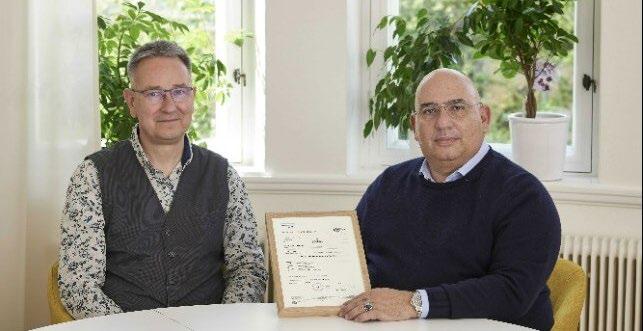
27 minute read
classification
from BTI Summer 2022
by Maritime-AMC
CLASS ACTION
Classification societies are facing a number of challenges as the maritime industry prepares itself for increasing levels of regulations relating to the environment
Owners, operators and port facilities will have to ensure that they comply with the new rules and meet the deadlines put in place not only by organisations like the International Maritime Organization (IMO), but also government and country groups.
Meeting in London recently, the International Association of Classification Societies (IACS) Council, chaired by CEO of Lloyds Register Nick Brown, held its 85th session (C85).
The Council recognised the challenge of ensuring that ambitious targets with expedited timescales for decarbonisation are delivered safely and with the necessary technical underpinning to facilitate early investment by key stakeholders.
IACS panels represent the top tier of the Association’s issue-specific bodies, so establishing a Safe-Decarbonisation Panel (SDP) sends a clear signal of IACS’ determination to support industry through this multi-faceted, multi-decadal challenge. Giving decarbonisation the same focus as the traditional areas of safety, environment, hull, machinery, survey and cyber enhances the association’s ability to address safe decarbonisation concerns and support the protection of human life, property and the marine environment.
To help deliver common technical requirements at speed, the SDP will immediately convene four project teams to work on leading decarbonisation fuels and technologies.
While IACS remains technologically agnostic, extensive discussions with industry – itself a key feature and objective of the SDP – indicate that initial efforts should be focused on ammonia, hydrogen, carbon capture and storage and batteries. Additionally, the SDP will also evaluate current work streams at IMO on methyl/ethyl alcohols with a view to undertaking further work as appropriate. Other alternative fuels and technologies will be considered by the SDP subsequently.
Recognising that efforts to decarbonise need to be collaborative to be successful, the SDP has also adopted a structured consultative approach so that all stakeholders – fuel manufacturers, technology providers, owners, builders and marine insurance – have multiple and multilayered opportunities to engage with IACS at strategic, operational and technical levels.
Such close cooperation will help focus prioritisation, maximise efficiency and remove duplication and allow for the resulting outputs to be properly targeted either in the form of IACS resolutions or recommendations or submissions to IMO to support the development of detailed regulations. Collectively, this work will help encourage industry to invest in new fuels/technologies by offering a degree of reassurance that standards are being harmonized and technologies are proven against these requirements.
Commenting on this development, Brown said: “IACS’ establishment of a Safe Decarbonisation Panel allows for an over-arching view on new initiatives, whether they be related to the propulsion of the vessels or to the changing nature of the cargoes ships will carry as a result of societal efforts to decarbonise, and so marks a stepchange in embedding a safety-focus into this industry-wide effort.”
The meeting also reviewed the suite of measures adopted by IACS to help the industry maintain business continuity in the face of the operational challenges posed by the covid-19 pandemic and noted the effectiveness of IACS’ covid19 task force in ensuring that ships were able to safely remain in service and in compliance with Class Rules and the requirements of the international Conventions. C85 agreed, however, that the improving covid situation now allowed for a phased withdrawal of the various exemptions, noting that operational challenges still exist in certain areas.
IACS: EEXI
IACS has recently published guidelines on the implementation on the Energy Efficiency Existing Ship Index (EEXI)
The mandatory nature of International Maritime Organization’s Energy Efficiency Existing Ship Index (EEXI) means it has a significant role to play in ensuring that the industry remains on track to meet greenhouse gas reduction targets.
IACS is fully supportive of IMO’s initiatives on decarbonisation and has played an essential role in the development of EEXI by the IMO’s Marine Environment Protection
Committee (MEPC) through the provision of technical comments and proposals across ten submissions relating to ship energy efficiency and carbon intensity (EEDI/EEXI/CII), four of which focus on EEXI.
In addition to its work at IMO, IACS Recommendation No. 172 (Rec.172) has been developed to support the global and consistent implementation of the newly developed EEXI IMO framework by providing additional advice and guidance on certain elements of the regulatory text where cross-industry discussions had identified technical implementation nuances associated with the EEXI framework.
Specific issues identified as needing further elaboration in Rec.172 include: l the approval of the EEXI Technical File; non-overridable power limitation l EEXI calculation methodology for LNG Carriers; ship type applicability l appropriate Specific Fuel Consumption (SFC) values l the uniform performing & validating of numerical calculations of the EEXI reference speed (Vref).
With the amendments to MARPOL Annex VI incorporating mandatory EEXI becoming effective on 1 November 2022 and taking effect at the shipboard level on 1 January 2023, it remains vitally important for IACS to provide and maintain clarity and to allow relevant stakeholders to benefit from a common approach among IACS members in the calculation of a ship’s EEXI.
IACS secretary general Robert Ashdown says: “IACS is in a unique position to assist industry in complying with complex decarbonisation regulations by providing technical guidance that can help to maintain clarity while also enabling the practical and consistent application of this index on a global scale.”
iacs: cyber safety
Recognising that cyber incidents on vessels can have a direct and detrimental impact on life, property, and the environment, IACS has steadily increased its focus on the reliability and functional effectiveness of onboard, safety-critical, computerbased systems.
IACS identified at an early stage that, for ships to be resilient against cyber incidents, all parts of the industry needed to be actively involved and so convened a Joint Working Group (JWG) on Cyber Systems, which helped identify best practices, appropriate existing standards in risk and cyber security, and a practical risk-based approach.
Building on this extensive collaboration and utilising the experience gained from its existing recommendations, as well as developments at the International Maritime Organization (IMO) including, in particular, IMO Resolution MSC.428(98) applicable to in-service vessels since the 1st of Jan 2021, IACS has adopted two new IACS Unified Requirements (URs) on the cyber resilience of ships:
UR E26 aims to ensure the secure integration of both operational technology and information technology equipment into the vessel’s network during the design, construction, commissioning, and operational life of the ship. This UR targets the ship as a collective entity for cyber resilience and covers five key aspects: equipment identification, protection, attack detection, response, and recovery.
UR E27 aims to ensure system integrity is secured and hardened by third-party equipment suppliers. This UR provides requirements for cyber resilience of onboard systems and equipment and provides additional requirements relating to the interface between users and computer-based systems onboard, as well as product design and development requirements for new devices before their implementation onboard ships.
These URs will be applied to new ships contracted for construction on and after 1 January 2024, although the information contained therein may be applied in the interim as non-mandatory guidance.
IACS secretary general Robert Ashdown says: “These two URs on cyber safety provide minimum goal-based requirements for the cyber resilience of new ships and for the cyber security of onboard systems and equipment. In an increasingly connected and digitised maritime world, these URs represent a significant milestone in IACS’ work to deliver safer shipping in the face of continuously evolving technological developments.”
iacs: Remote surveys
The significant impact of the covid19 pandemic on the maritime industry resulted in an increase in the deployment of remote surveys by IACS members to ensure the maritime industry was able to continue functioning in as smooth and efficient a manner as possible.
Noting many IACS members introduced remote survey aspects prior to the pandemic, advancements in Information and Communication Technologies (ICT), together with the experience and knowledge gained during the pandemic, means that remote surveys will increasingly form part of IACS members’ operations, given the many advantages that can be achieved in terms of practical delivery while ensuring the same quality and safety levels.
To ensure all IACS members have uniform guidance and requirements on remote surveys, it was considered essential to develop minimum common requirements for the implementation of remote surveys.
This IACS Unified Requirement UR Z29 has been developed to deliver the core objective that a remote survey will only be appropriate when the survey is carried out without compromising the quality and results of such survey, providing the same level of assurance as those performed by a surveyor attending onboard the vessel.
To achieve this fundamental goal, it was essential that IACS developed principles to ensure equivalency between remote survey and traditional survey by establishing a general definition, application scope, conditions and limitations of remote survey together with identification of requirements in terms of training of personnel.
IACS Unified Requirement on Remote Classification Surveys UR Z29 will enter into force on 1 January 2023.
SEASKILL SERVICE MANAGER TORSTEN SCHRÖDER AWARDED SEABLY’S CEO ANDREA LODOLO THE CERTIFICATION ON BEHALF OF DNV LAST WEEK (CREDIT: SEABLY) DNV: Training platform
DNV has awarded the Swedish maritime training platform Seably a new DNV competence certification for its digital services.
The DNV SeaSkill standard ST-0595 is the first of its kind and addresses an emerging trend in the maritime training market: the emergence of training platform providers.
The standard’s certification framework aims to ensure the quality of the training platforms, as well as their learning products and operation. It was developed in co-operation with Seably as a pilot customer.
Rapid digitalisation, a move to offer more learning experiences on board and two years of operating during a global pandemic have transformed the maritime training market. Greater digital portfolios and local providers seeking access to learners from around the world have led to the emergence of digital training platforms. They offer local providers the opportunity to elevate their courses beyond their regional market and gain access to customers worldwide.
Andrea Lodolo, CEO of Seably, says: “I am delighted that we have been able to work with DNV on the ST-0595 standard, which is open and will be available for any organisation in the maritime sector to achieve. It was of great importance to us that we pioneered this for the benefit of the whole sector, and not just the select few. There has been tremendous progress in technology and learning skills, and Seably has been at the forefront, driving innovation through our unique marketplace. This standard recognises this progress while setting the bar to maintain the quality and robustness that seafarers rightly expect from their training and development. We look forward to seeing many more companies attain the standard in the future.”
“Making learning experiences widely accessible to seafarers is a very positive development for an industry that is becoming increasingly demanding as it heads into a digitalized, decarbonized future,” says Ulrich Bernhardt, head of competence and learning and SeaSkill™ at DNV. “However, while we welcome this trend, it is equally important to ensure that training platform providers have a robust management system in place which accounts for the challenges of their unique operational environment.”
DNV: Compliance planner
DNV has updated its recently released Compliance Planner. The digital tool will now enable DNV customers to monitor their entire fleets and individual vessels against Flag State compliance requirements.
International shipping and offshore regulations are expanding in scope and complexity, increasing the burden on ship owners and operators. Designed to provide an overview of International Maritime Organization, International Labour Organization and European Union requirements, DNVs Compliance Planner has now been updated to incorporate Flag State requirements, providing an enhanced overview for users.
Furthermore, the tool is continuously updated to reflect the latest decisions of regulators and includes several options for demonstrating compliance. Following considerable industry interest, the tool has also been expanded to cover MOUs.
dnv: hydrogen forecast
Hydrogen has a crucial role in decarbonising the world’s energy system, but uptake will be too slow. Governments need to make urgent, significant policy interventions, according to a new report by DNV.
In Hydrogen Forecast to 2050, DNV predicts the amount of hydrogen in the energy mix will be only 0.5% in 2030 and 5% in 2050. However, to meet the targets of the Paris Agreement, hydrogen uptake would need to triple to meet 15% of energy demand by mid-century.
“Hydrogen is essential to decarbonise sectors that cannot be electrified, like aviation, maritime, and high-heat manufacturing and should therefore be prioritized for these sectors,” says Remi Eriksen, group president and CEO of DNV. “Policies do not match hydrogen’s importance. They will also need to support the scaling of renewable energy generation and carbon capture and storage as crucial elements in producing low-carbon hydrogen.”
According to Hydrogen Forecast to 2050, electricity-based green hydrogen – produced by splitting hydrogen from water using electrolysers – will be the dominant form of production by the middle of the century, accounting for 72% of output. This will require a surplus of renewable energy, to power an electrolyser capacity of 3,100 gigawatts. This is more than twice the total installed generation capacity of solar and wind today.
Blue hydrogen – produced from natural gas with emissions captured – has a greater role to play in the shorter term (around 30% of total production in 2030), but its competitiveness will reduce as renewable energy capacity
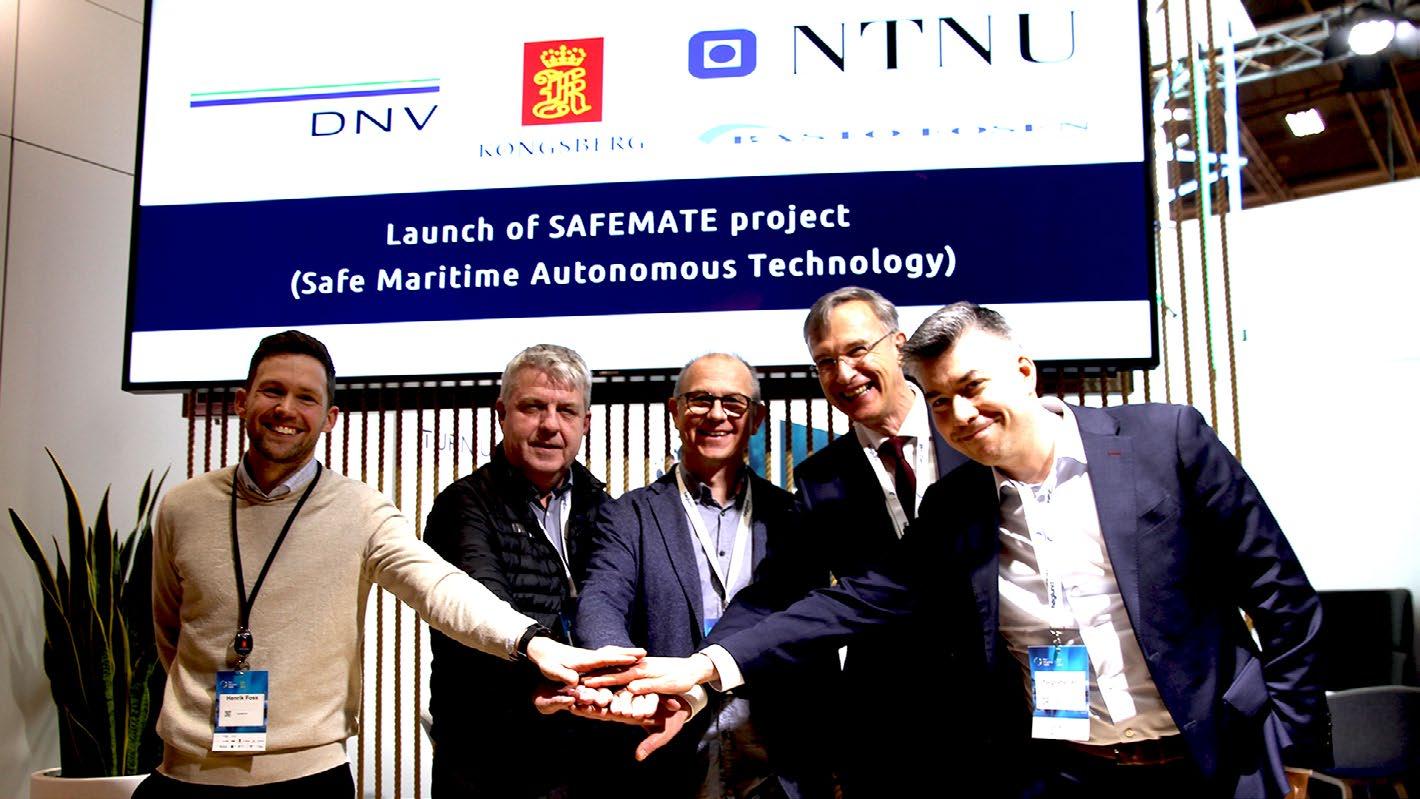
DNV, KONGSBERG MARITIME, KONGSBERG SEATEX, BASTØ FOSEN AND NTNU ANNOUNCED THE LAUNCH OF THE NEW SAFE MARITIME AUTONOMOUS TECHNOLOGY (SAFEMATE) PROJECT, AT THE RECENT NOR-SHIPPING TRADE FAIR LEFT TO RIGHT: HENRIK FOSS, PRODUCT MANAGER, KONGSBERG SEATEX AS; BØRRE FLAGLIEN, DIRECTOR OF BRIDGE SYSTEMS AT KONGSBERG MARITIME; OTTAR OSEN, PROFESSOR AUTOMATION AT NTNU; PIERRE SAMES, GROUP RESEARCH AND DEVELOPMENT DIRECTOR AT DNV; JAN-EGIL WAGNILD, CTO AT TORGHATTEN AS (CREDIT: TORGHATTEN AS).
increases and prices drop.
Global spend on producing hydrogen for energy purposes from now until 2050 will be US$6.8tn, with an additional $180bn spent on hydrogen pipelines and $530bn on building and operating ammonia terminals, according to DNV’s forecasts.
Cost considerations will lead to more than 50% of hydrogen pipelines globally being repurposed from natural gas pipelines, as the cost to repurpose pipelines is expected to be just 10-35% of new construction costs. Hydrogen will be transported by pipelines up to medium distances within and between countries, but not between continents.
Global hydrogen trade will also be limited by the high cost of liquefying hydrogen for ship transport and the low energy density of hydrogen. The hydrogen derivative ammonia, which is more stable and can be more readily transported by ship, will be traded globally.
Early uptake of hydrogen will be led by hard-to-abate, high-heat manufacturing processes such as iron and steel production which currently use coal and natural gas. Hydrogen derivatives, such as ammonia and methanol, are key to decarbonising heavy transport like shipping and aviation, but these fuels won’t scale until the 2030s, according to DNV’s forecasts.
Hydrogen will not see uptake in passenger vehicles and only limited uptake in power generation. Hydrogen for heating of buildings will not scale globally, but will see early uptake in some regions that already have extensive gas infrastructure.
“Scaling hydrogen value chains will require managing safety risk and public acceptance, as well as employing policies to make hydrogen projects competitive and bankable. We need to plan at the level of energy systems, enabling societies to embrace the urgent decarbonisation opportunities presented by hydrogen,” adds Eriksen.
The uptake of hydrogen will differ significantly by region, heavily influenced by policy. Europe is the forerunner with hydrogen set to take 11% of the energy mix by 2050, as enabling policies both kickstart the scaling of hydrogen production and stimulate end-use. OECD Pacific (hydrogen 8% of energy mix in 2050) and North America (7%) regions also have strategies, targets, and funding pushing the supply-side, but have lower carbon-prices and less concrete targets and policies. Greater China (6%) follows on, recently providing more clarity on funding and hydrogen prospects towards 2035, coupled with an expanding national emissions trading scheme. These four regions will together consume two-thirds of global hydrogen demand for energy purposes by 2050. THE SAFEMATE PROJECT WILL PILOT AN AUTOMATED NAVIGATION DECISION SUPPORT SYSTEM ON THE BASTØ VI FERRY (BELOW) (CREDIT: TORGHATTEN AS)
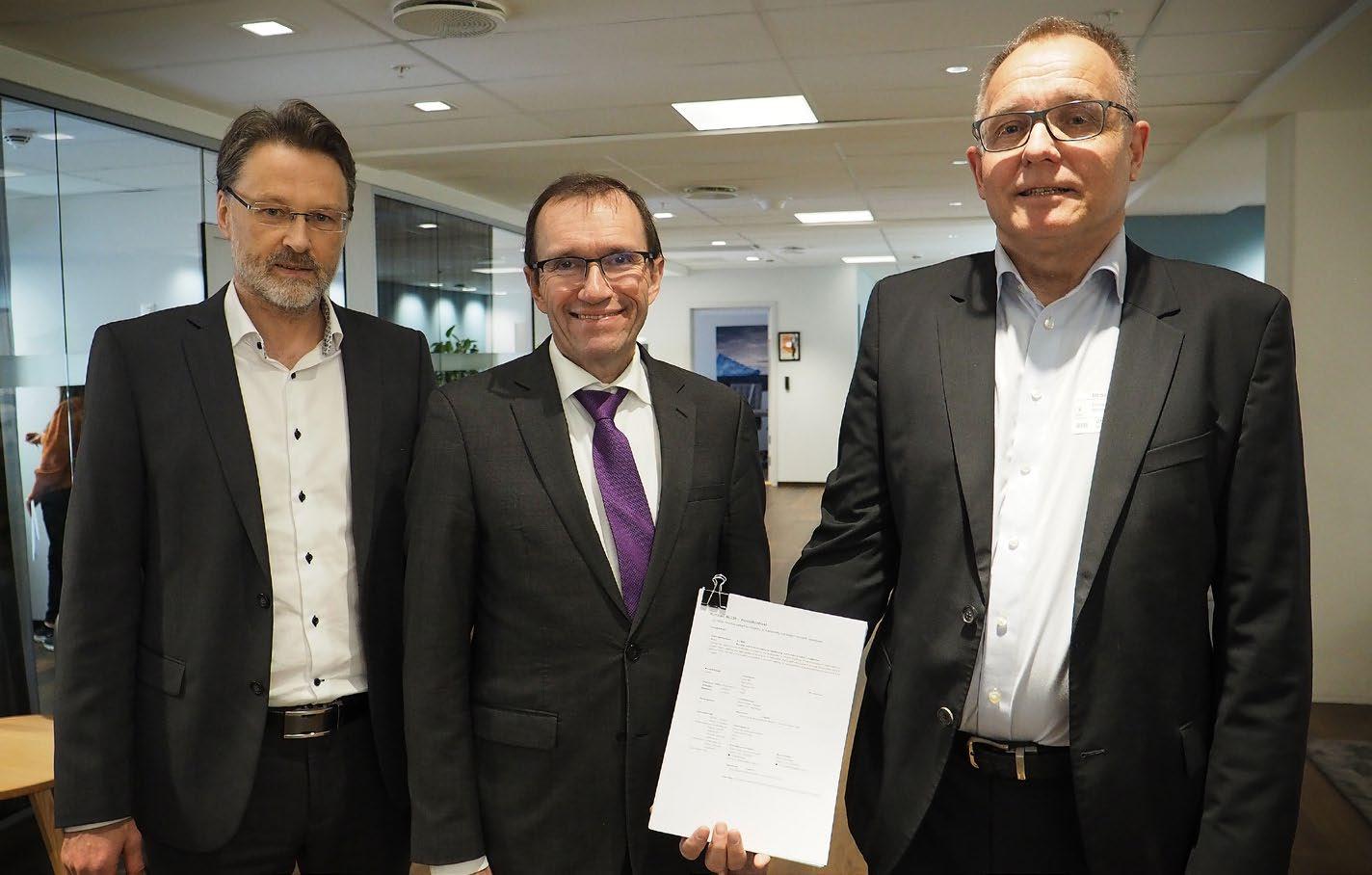
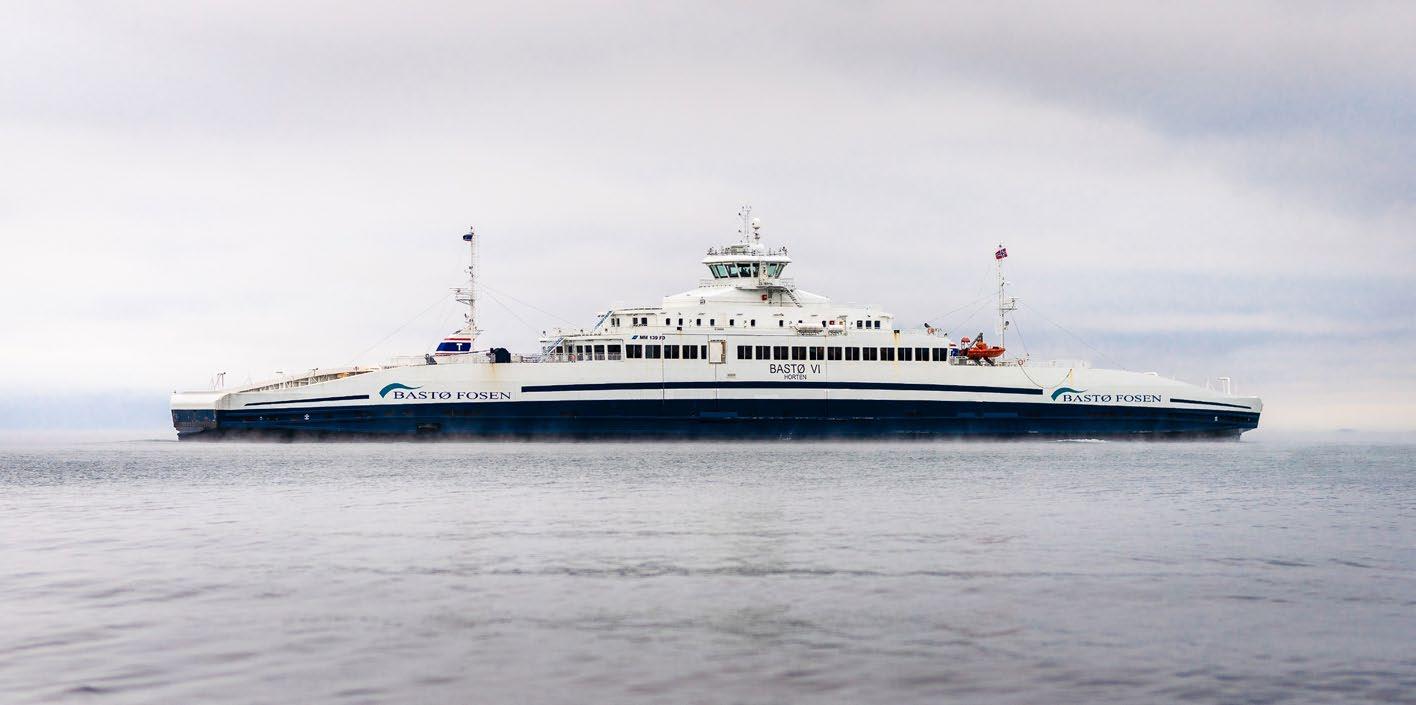
dnv: SEEMP generator
DNV is set to launch its SEEMP III Generator, as part of an integrated and easy digital solution to support customers in ensuring their compliance with SEEMP Part III verification. The remaining SEEMP Part III guidelines were adopted and published in June this year, with the deadline for having the first SEEMP Part III verified and onboarded by 1 January 2023.
The SEEMP Part III forms part of the International Maritime Organization’s (IMO) initial strategy to reduce greenhouse gas (GHG) emissions from ships, including the ambition to reduce the carbon intensity as an average across international shipping by at least 40% by 2030, pursuing efforts towards 70% by 2050 compared to 2008. The requirement will require affected vessels to submit a three-year implementation
plan describing how it will achieve the required Carbon Intensity Indicator (CII). The IMO’s CII will rate MARPOL ship types above 5,000 GT on a scale from A to E on how efficiently they transport goods or passengers with regards to CO2 emitted. For vessels obtaining an inferior rating the SEEMP III report must be updated with a corrective action plan which must be verified before a Statement of Compliance (SoC) can be issued.
“With only six months to go to ensure compliance with the new MARPOL regulation and meet the SEEMP III verification deadline, ship owners need to take immediate action,” says Sven Dudszus, head of GHG certification at DNV Maritime. “Through our considerable experience running DCS and Emissions Insights reporting for our customers, DNV is uniquely positioned to take the pressure off customers, giving them the peace of mind that they can achieve compliance in this relatively tight time frame.”
The SEEMP Part III is intended to help companies achieve the required CII. It is a dynamic document subject to regular updates and revisions, reflecting the changing performance and required measures. To help customers tackle the impending SEEMP III challenge, DNV has developed two pathways.
BV: pilot project
Bureau Veritas and Laskaridis Shipping and METIS Cyberspace Technology, which provides ship environmental and operational performance smart tools, have agreed to embark on a pilot project to develop and apply a new BV SMART 3 Class notation covering the use of augmented data in ship operations.
Modern ships increasingly use smart systems designed to improve their operational efficiency. As part of its strategy to support maritime digitalisation, BV has developed a framework of SMART notations for ships, which provide consistent and uniform standards for the ‘smart’ techniques used to monitor and improve fleet performance.
In a new ‘Smartship’ pilot project, BV is working with Laskaridis Shipping and METIS to develop a range of additional class notations adapted to the latest advances in digitalisation technology, with a focus on augmented ship. The SMART 3 notation will also cover ship to shore connectivity, remote decision support and remote operations.
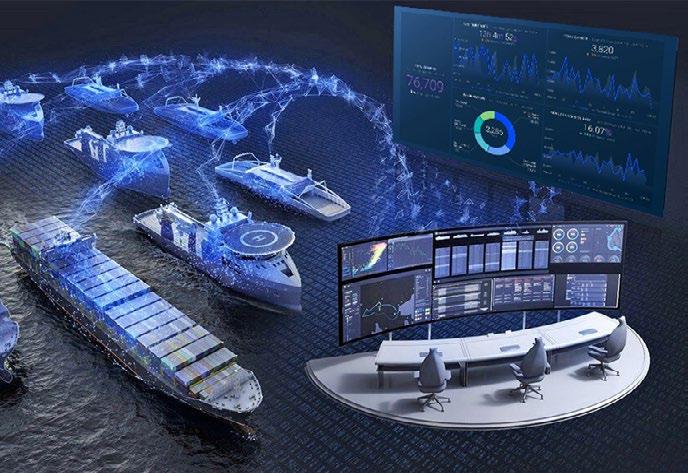
BUREAU VERITAS, LASKARIDIS SHIPPING, AND METIS CYBERSPACE TECHNOLOGY ARE TO EMBARK ON A NEW PARTNERSHIP TO ADVANCE AUGMENTED SHIP SERVICES
BV: Machinery maintenance
Bureau Veritas (BV) has launched a new digital tool – Machinery Maintenance – that connects directly to owners’ Computer Machinery Maintenance System (CMMS) and helps them transition to optimised machinery maintenance schemes.
For ship operators to sail safely, their vessels must undergo regular inspections of their machinery equipment and systems. However, most modern ships have more than 300 separate pieces of machinery onboard, each with its own specific maintenance requirements. This poses a challenge to ship owners and operators on how to conduct machinery maintenance regularly, but also efficiently.
The new BV Machinery Maintenance platform connects ship operators’ maintenance system with BV’s system, thereby facilitating the elaboration of a Planned Maintenance Survey System (PMS) plan with online guided booking.
Laurent Hentges, vice president, digital solutions and transformation at Bureau Veritas Marine and Offshore, comments: “We know that efficient maintenance can have a major impact on vessel operations. As greater digitalisation and improved monitoring technology have become available, owners can now move to upgraded systems that further optimise maintenance planning, reliability and costs.
“As a classification society, we have a crucial role to play in helping ship owners transition to optimised machinery maintenance systems. We are very pleased to introduce this new tool to help them save time and money.”
BV: power generator
Bureau Veritas recently approved the second generation of the REXH2 developed by Energy Observer Developments (EODev), a turnkey power generator for the supply of low carbon electricity on board ships. The hydrogen PEM fuel cell at its heart makes it possible to meet energy needs ranging from 70kW to about one megawatt when several REXH2 are installed in parallel.
The Approval in Principle (AIP) obtained by EODev for its REXH2® fuel cell design follows a thorough design review against the latest classification rules and regulations, assessing its compliance with the IGF Code specific safety regulations for vessels using gases and low-flashpoint fuels. It also follows the recently released BV NR 547, applicable to the use of fuel cells onboard ships.
BV: new notation
Bureau Veritas has announced the development of a new notation, CII REALTIME. The notation will support shipowners to provide reliable and up-to-date data related to DCS and CII of their ships/fleet in a simplified and consistent process.
It is hard to overstate the scale and the urgency of the challenges that shipping now faces. Shipowners have less than a year to prepare their vessels to comply before the new EEXI and CII regulations come into effect, on 1st January 2023.
Monitoring the evolution of the CII during the year is essential to avoid any surprises with the ship’s energy rating and to make early and informed decisions on operational measures. Danaos Management Consultants has developed digital solutions to efficiently manage such monitoring and to facilitate engine performance optimisation.
Bureau Veritas is teaming up with Danaos to develop the notation, which will recognise the implementation of a digital process that helps to collect DCS data and compute the CII data on a regular basis. The notation process will cover the data collection from ship as well as the ship-to-shore transfer data on to Bureau Veritas servers.
bv: Cyber tools
Marlink, the smart network group, and classification society Bureau Veritas, recently signed an agreement to accelerate the delivery of cyber-secure digital tools and safety services in the maritime industry.
The agreement links Marlink’s smart hybrid connectivity with the remote digital and safety services provided by BV. Having identified crossovers in their mutual customer base, the partners will collaborate to help enable maritime stakeholders to more easily adopt cyber-strengthened digital tools and applications using the Marlink network.
The partners have put in place a working group to support shipowners around improving the cyber-security of vessel data collection and facilitating compliance with regulation. This will support remote and digital operation modes on a journey to smarter, remote and, ultimately, autonomous ships with zero-emission.
“This is a partnership with real purpose whose foremost point is to take action to integrate digital tools and services that can bring value for shipowners and encourage and further develop cyber-secure, innovative Class operations,” says Matthieu de Tugny, president, Bureau Veritas, Marine & Offshore.
“Shipowners face huge efficiency and compliance challenges over the next decade and these need to be considered now to create a future-proof path that can integrate core operational components onboard and ashore,” says Tore Morten Olsen, president of maritime at Marlink.
“Digitalisation is critical to improving voyage optimisation and vessel performance, achieving regulatory compliance and meeting environmental, social and governance goals, but shipowners shouldn’t have to act as project managers – this partnership means they can streamline and simplify their digital journey based on Class guidelines and recommendations.”
bv: Fuel cells
Bureau Veritas has released a new rule note (NR 547) on fuel cell power systems on board ships. The rule note covers safety requirements for ships using any type of fuel cell technology, providing rules for the arrangement and installation of fuel cell power systems and the delivery of electrical energy.
Over the past few years, fuel cells have proved to have strong potential to help decarbonise the maritime industry. The technology, which is based on an electrochemical reaction like that in batteries, can run continuously without recharging as long as energy is provided.
Fuel cells can bring significant environmental benefits, eliminating NOx, SOx and particle emissions while reducing CO2 emissions compared with diesel engines. However, this technology comes with a number of challenges that must be addressed to ensure safety.
Bureau Veritas’ NR 547 outlines requirements on the design, construction and installation of fuel cells systems to ensure that the safety of the ship is maintained. The aim is to identify and mitigate risks to persons on board, the environment and the structural integrity of vessels. Fuel cell systems and ship design must limit the risk of explosions, the spread of toxic chemicals and fire outbreaks.
Laurent Leblanc, senior vice president technical and operations at Bureau Veritas Marine & Offshore, comments: ‘Our new rule responds to the latest advances in fuel cell technology, and incorporates information from the most recent industry-wide collaborations.
“For shipowners and operators taking the fuel cell route to sustainability, NR 547 lays the groundwork for operating safe, sustainable, and highperformance vessels.
kr: Autonomous navigation
Korean Register (KR) has signed a Memorandum of Understanding (MOU) with KLCSM and Samsung Heavy Industries (SHI) to jointly research and approve the application of autonomous navigation systems for mid- to largesized vessels.
The agreement will accelerate the commercialisation and international competitiveness of domestic autonomous ship equipment and technology by establishing an actual ship-based autonomous operating system that is jointly developed between domestic shipping companies, shipyards and KR.
The announcement comes as an increasing number of shipowners integrate artificial intelligence (AI), Internet of Things, Big Data and sensor systems into their vessels in order to assist vessel crews.
In addition to this MOU, KR has been building up its related classification certification performance and autonomous navigation ship technology by applying its rules, cyber-security certification and risk-based approval in accordance with its Guidance for Autonomous Ships, which was published in 2019.
KR: new centre
The Korean Register held an inauguration ceremony for its new Integrated Survey Centre (ISC) at the company’s headquarters in Busan, Korea, in April.
KR-ISC is an in-house developed digital platform that interactively exchanges data directly between shipping companies and KR to monitor its registered ships around the world at a glance, and to provide more systematic and integrated survey service.
During an emergency, KR-ISC can provide immediate technical support to customers for making key decisions by identifying the ship’s condition in real time using images and data sent from the vessel.
In addition, information on port state control inspection trends, detention cases, and deficiencies of individual ships can also be provided through
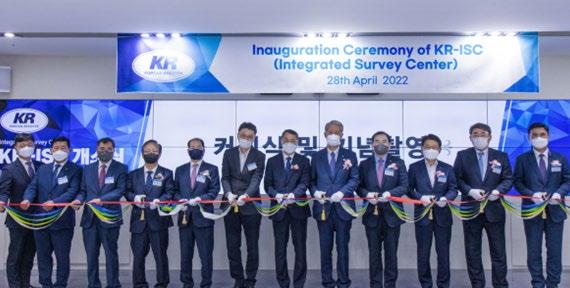
LEE HYUNGCHUL, KR CHAIRMAN AND CEO (FIFTH FROM RIGHT), JEONG TAESEONG, MINISTRY OF OCEANS AND FISHERIES DIRECTOR (SIXTH FROM RIGHT), PARK CHANMIN, KLCSM CEO (FOURTH FROM RIGHT), AND DISTINGUISHED GUESTS TAKE A COMMEMORATIVE PHOTO AT THE INAUGURATION CEREMONY FOR KR-ISC
KR SURVEYORS HAVE A TECHNICAL MEETING AT KR-ISC KR-ISC, contributing to the smooth entry and departure of vessels by supporting real-time PSC responses when needed.
“KR-ISC is the result of KR’s considerable efforts to build a digitalised survey system as a key element of the society’s progress towards becoming an advanced digital classification society,” said Lee Hyungchul, KR chairman and CEO, during the inauguration ceremony.
“The KR-ISC will provide a higher level of survey capability using advanced technology ensuring our clients can continue to operate their ships safely and efficiently.”
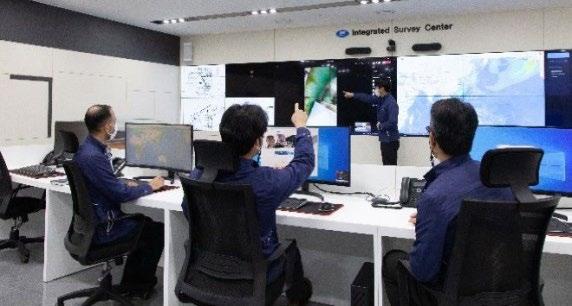
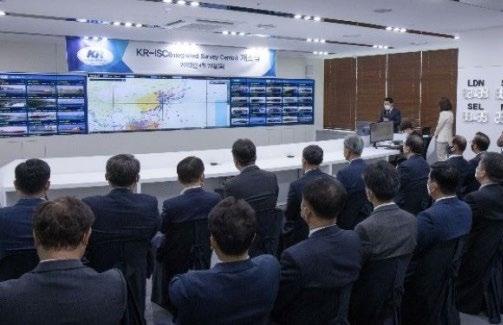
KR: carbon lens
KR has recently awarded Singaporebased Marine Technology Solution Pte Ltd a Type Approval certificate for their direct and continuous CO2 emission measurement system called Carbon Lens.
The Type Approval certificate, which was awarded based on the International Maritime Organization’s NOx Technical Code and Guidelines from KR, is the first of its kind to be awarded to a manufacturer.
Carbon Lens continuously analyses and records the flow of emitted CO2 from each stack of a vessel, taking into account its temperature and exhaust pressure. This data is then livestreamed from the vessel to designated recipients ashore.
By utilising this system, recorded and reported data will be more immediately available and more accurate, offering a significant improvement on the current “best-guess techniques” employed by many emission reporting companies at the moment.
Being able to accurately measure and report CO2 emission levels from vessels is increasingly important to ship owners, managers and charterers, as they will be required to provide detailed emission reports to regulators.
Accurate data will also help the relevant parties to better estimate their carbon offset requirements when executing carbon trading strategies.
kr: Storage tanks
Korean Register (KR) has published comprehensive guidelines on the metal materials suitable for use in eco-friendly fuel storage tanks, such as those used for storing liquefied natural gas, ammonia, methanol and hydrogen.
The newly published Guidelines for Selection of Metallic Materials of Containment Systems for Alternative Fuels for Ship includes detailed technical information on all the metal materials suitable for such containment systems. It has been jointly developed by KR’s R&D division and KIM Yongjin’s research team of the Korea Institute of Machinery and Materials.
“KR conducts world-class research and development to benefit and support the wider maritime industry, regularly sharing its latest technological information,” says KIM Daeheon, Executive Vice President of KR R&D division. “These timely guidelines will be welcomed by universities, research institutes, shipowners and clients, indeed anyone who is working to develop eco-friendly vessels.”
KR has proposed suitable metal materials that can be used for containment systems (storage tanks) and for the supporting structures taking into account the characteristics of the various eco-friendly alternative fuels. Applicability evaluation methods and procedures are also included in the document.
The guidelines examine the various restrictions and technical limitations affecting metal materials used to contain liquid hydrogen, which is technically the most difficult to store in large capacities and currently hardly used for vessels as the gaseous hydrogen causes damage to materials.
lr: rotor sails
Lloyd’s Register (LR) has granted Approval in Principle for a SDARI (Shanghai Merchant Ship Design and Research Institute) designed 210,000 DWT Newcastlemax bulk carrier installed with Anemoi rotor sails to significantly improve efficiency and reduce environmental impact.
The Newcastlemax AIP is part of a pioneering joint development project (JDP), signed in 2020, with Anemoi Marine Technologies, Lloyd’s Register, and SDARI and brings together the OEM, classification society, ship designer, and ship owner to develop a series of energy-efficient vessel designs equipped with Rotor Sails. Oldendorff Carriers is the shipowner partner for this Newcastlemax design
Director of innovation Torsten Barenthin of Oldendorff Carriers comments: “This has been an important project as part of Oldendorff Carriers’ commitment towards Getting to Zero. The results have demonstrated the impressive impact Rotor Sails have on regulatory obligations, which is a key consideration, in addition to the emission reduction benefits. We will continue our assessment of Anemoi’s technology for our fleet.”
The AIP covers the structural integration for a ship design with six 5x30m rotor sails and Anemoi’s rail deployment system, which sees the rotor sails move transversely across the deck to avoid inference with cargo handling; and the structural integration for a ship design with four of Anemoi’s folding (tilting) 5x35m rotor sails.
LR has assessed the calculation used to estimate the impact the rotor Sails will have on the Energy Efficiency Design Index (EEDI) and validated that the newbuild Newcastlemax would have its EEDI score reduced from 1.92 to 1.37 (29% reduction) by installing six 5x30m rail rotor sails and 1.47 (23% reduction) by installing four 5x35m folding rotor sails.
Nick Contopoulos, Anemoi’s Chief Operating Officer, says: “We’re very pleased with the outcome for the first vessel included in the JDP. EEDI is a significant driver for the installation of rotor sail technology and, as we grow closer to the implementation of EEXI and CII, they too become important incentives for Rotor Sails, along with the overarching reductions in fuel consumption and associated emissions.
“To have the impact pre-validated by LR is a key step in continuing to prove the importance of our technology in the context of the decarbonisation of shipping. Both design configurations (folding and rail) of rotor sails for a Newcastlemax vessel are available to order now.”
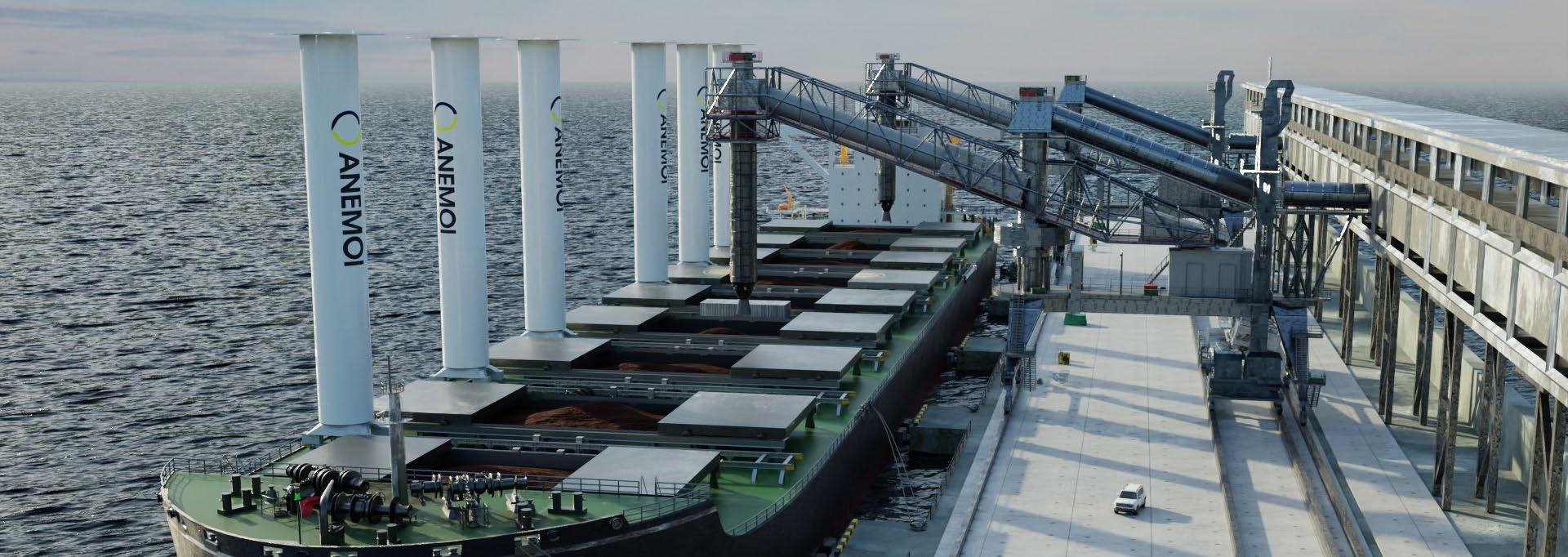
LLOYD’S REGISTER (LR) HAS GRANTED AN AIP FOR A SDARI -DESIGNED 210,000 DWT NEWCASTLEMAX BULK CARRIER INSTALLED WITH ANEMOI ROTOR SAILS










